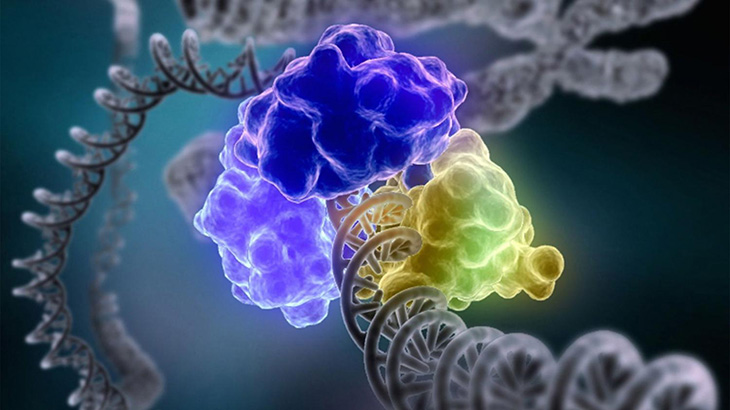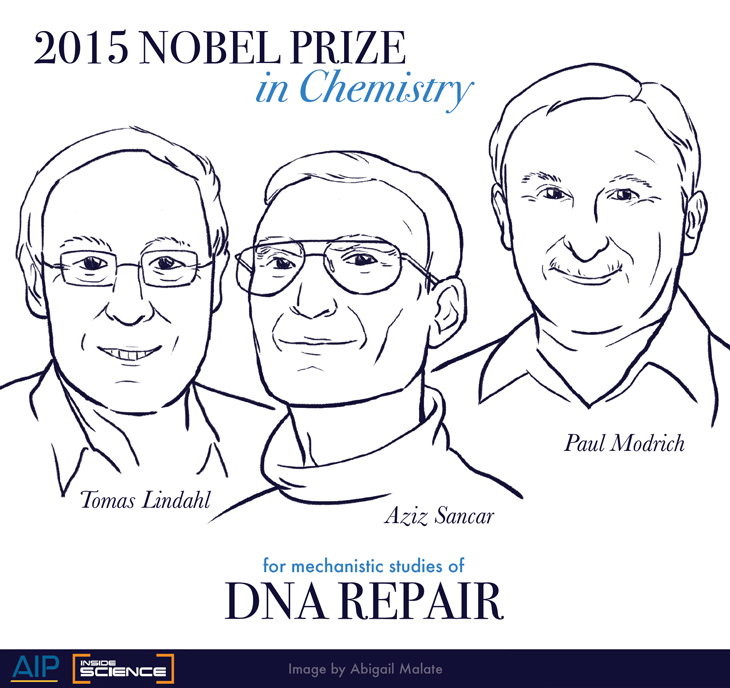Three Chemists Share Nobel For DNA Repair

David Gohara, Saint Louis University, and Tom Ellenberger, Washington University School of Medicine in St. Louis.
(Inside Science) -- The 2015 Nobel Prize in chemistry was awarded this morning to three men whose research uncovered three fundamental ways the body goes about repairing damaged DNA: Thomas Lindahl, a Swedish chemist from the Francis Crick Institute’s Clare Hall Laboratory in Hertfordshire, UK; Paul Modrich, an American chemist from the Howard Hughes Medical Institute and Duke University School of Medicine in Durham, North Carolina; and Aziz Sancar, a Turkish-American chemist from the University of North Carolina, Chapel Hill.
DNA molecules form the basic foundation of human life.
"In every single cell in our body, we have genetic material that encodes for the creation of a human being," said Claes Gustafsson, a member of the Nobel committee for chemistry, at a press conference announcing the prize this morning.
The DNA inside the cells of every adult human being is similar to the DNA in the fertilized egg that gave rise to all those cells by dividing over and over again. That means DNA must be able to replicate many trillions of times without changing, or life would as we know it would not exist.
Because humans do seem to grow and keep living without falling into genetic chaos, it was long assumed that DNA is a basically stable molecule that does not undergo excessive mutations. Lindahl discovered that this is far from the case.
In the late 1960s, Lindahl found that DNA is subject to many millions of damaging assaults every day. His research sought to uncover how DNA can be so unstable while human life remains more or less stable.
The answer: DNA has several ways of repairing itself.
"DNA is a very interesting molecule because there is only one molecule per cell, whereas proteins, RNA and so forth, have a lot of copies. So, the cell has to be very protective of that molecule and that's one reason these repair processes have evolved," said Stephen Lippard, an inorganic chemist at MIT in Cambridge, Massachusetts.
"Life as we know it today is totally dependent on DNA repair mechanisms," said Sara Snogerup Linse, chair of the Nobel committee for chemistry, during a press conference.
Lindahl's research led him to discover a repair mechanism called base excision repair.
DNA strands come in pairs, and each strand is made of building blocks called nucleotides. Those nucleotides in turn contain one of four main bases that define the genetic code: adenine, cytosine, guanine and thymine. They can become damaged during normal metabolic activity. When a base is damaged, the DNA strands may pair incorrectly. Base excision repair can discover a damaged base, remove the faulty nucleotide containing that base, fill the gap and seal the DNA strand.
Lindahl mapped out how this repair works and recreated the DNA repair process in human DNA through test-tube experiments.
Modrich uncovered the way DNA repairs itself when its bases become mismatched during replication. Building on research by molecular biologist Matthew Meselson and in later collaborations with Meselson, Modrich developed a virus containing DNA that had several mismatched base pairs. They found that many of these base pairs were naturally corrected when exposed to bacteria as the DNA within the virus replicated. They studied and mapped those corrections in great detail and published their findings in 1989.
Sancar turned his attention to repairs made by DNA in response to damage due to ultraviolet light. In the 1970s he observed that bacteria exposed to deadly doses of UV radiation recovered when illuminated with blue light.
Further study of the chemistry behind this remarkable recovery led him to discover nucleotide excision repair, which allows DNA to recover from damage caused by UV radiation or other carcinogenic substances, such as cigarette smoke.
The mechanism is similar to that of the base excision repair that Lindahl studied. Instead of removing one broken nucleotide, though, enzymes responsible for the repair remove about a dozen nucleotides surrounding the damaged area, replace all of them and seal the strand.
He published his work in 1973.
Lippard, who worked with Sancar on nucleotide excision repair, was especially thrilled to see his colleague's work recognized by the Nobel committee.
"I view [Sancar] as one of the greatest scientists on the planet," said Lippard. "He's got deep insights and he taught me a great deal that was quite valuable in my own work."
As more is understood about the ways in which DNA is repaired, researchers can use these insights to develop strategies to fight diseases such as cancer and a host of genetically controlled and inherited maladies, said Lippard.
"We want to understand the repair mechanisms in some detail so that we can prevent the cancer cells from repairing DNA when we, for example, expose them to radiotherapy," said Lindahl in an interview with Adam Smith of Nobelprize.org.
"I think there's really no end to the frontiers of how DNA repair will be important in medicine going forward," said Lippard.
Each of the new laureates were excited to see their work recognized in one of science's top honors.
"It's always nice at the end of your career to have recognition that what you have done is actually important," said Lindahl.

